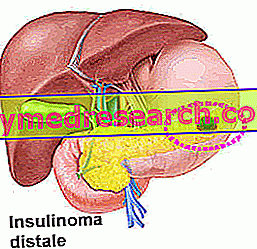Generality
Insulinoma is a tumor that affects the pancreas, in particular the cells involved in insulin synthesis. Among all, insulinoma is the most frequent endocrine tumor of the pancreas, malignant in about 5-15% of cases.
Because of this tumor process, pancreatic β cells from the Langerhans islands synthesize and release excessive amounts of insulin, with an inevitable glycemic decline, especially in the fasting state.
Symptoms
To learn more: Symptoms Insulinoma

Continuous carbohydrate intake for the purpose of controlling hypoglycemia often results in increased patient weight. The symptoms of insulinoma worsen after exercise, alcohol intake, low-calorie diets and sulphonylurea treatment.
The hypoglycemic crises are corrected with the administration of simple carbohydrates; as soon as the crisis is resolved, foods rich in protein and carbohydrates with a medium and low glycemic index will be taken.
Insulinoma is a fairly rare tumor, given that its incidence is estimated at one in 250, 000 individuals per year. Generally, insulinoma is single and small (<2 cm), and only about 10% of patients are recognized as having multiple insulinomas. It mainly affects males in adulthood between the third and sixth decades of age.
Diagnosis
The diagnosis of insulinoma is based mainly on blood tests; it is positive when particularly high levels of insulin, C peptide and proinsulin are shown on a blood sample taken after a prolonged fast, compared with low blood sugar levels.
The traditional imaging methods (CT, echography and nuclear magnetic resonance) provide a limited diagnostic contribution, given the difficulties in identifying these neoplasms, mainly due to the particularly small dimensions.
For diagnostic purposes, specific drugs can be administered to stimulate the release of insulin by pancreatic neoplastic cells. Sometimes, we proceed with the selective injection of a hyperosmolar calcium solution into the artery that irrigates the pancreatic region where insulinoma is located; the intra-arterial injection of calcium determines the release of large concentrations of insulin within the portal system, therefore in the hepatic veins, which can be precisely dosed by sampling.
Treatment
The treatment of insulinoma passes mainly through the surgical removal of the pancreatic tract affected by the tumor; the operation must preserve at least 15% of the gland so that it can produce sufficient amounts of enzymes and hormones.
In subjects who cannot be subjected to this type of operation, or in cases in which the insulinoma cannot be totally removed, insulin secretion is reduced by administering the drug diazoxide (100-200 mg per os x 2-3 intakes / day; 12 mg / kg body weight in children).
This medicine is often accompanied by a diuretic to prevent water retention problems. Other drugs that can be used are the octeocride, glucocorticoids, phenytoin and calcium channel blockers. When possible, however, the removal of insulinoma is decisive in the majority of patients.



